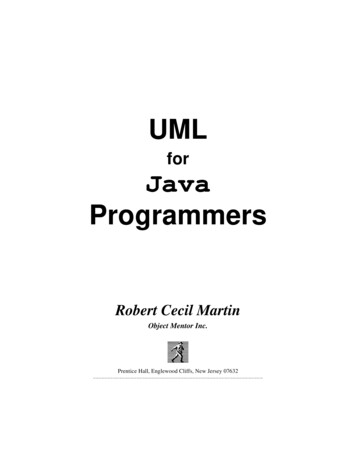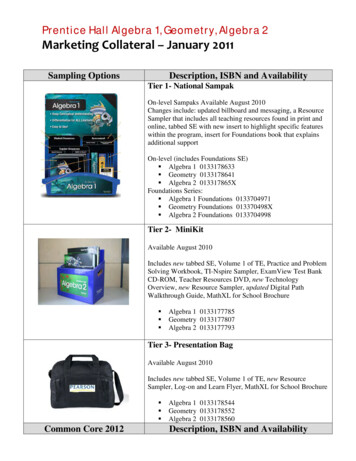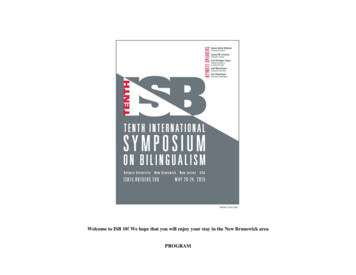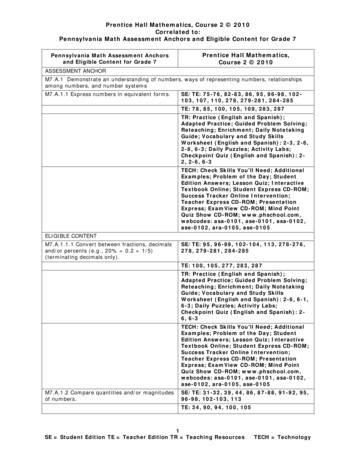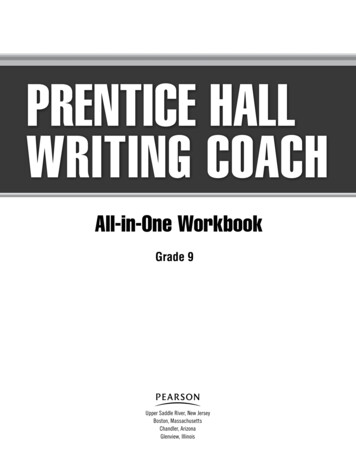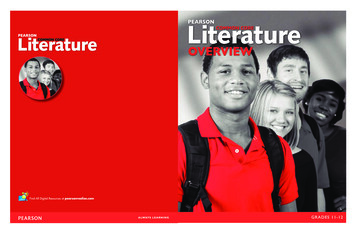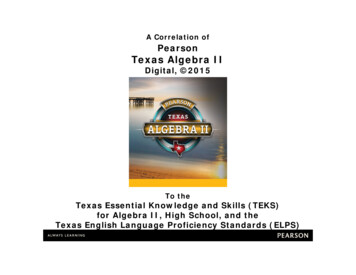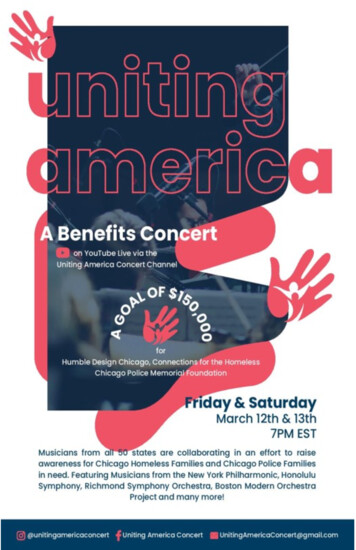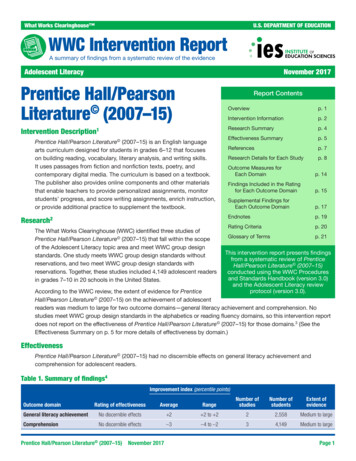
Transcription
What Works Clearinghouse U.S. DEPARTMENT OF EDUCATIONWWC Intervention ReportA summary of findings from a systematic review of the evidenceAdolescent LiteracyNovember 2017Prentice Hall/PearsonLiterature (2007–15)Report ContentsIntervention Description1Prentice Hall/Pearson Literature (2007–15) is an English languagearts curriculum designed for students in grades 6–12 that focuseson building reading, vocabulary, literary analysis, and writing skills.It uses passages from fiction and nonfiction texts, poetry, andcontemporary digital media. The curriculum is based on a textbook.The publisher also provides online components and other materialsthat enable teachers to provide personalized assignments, monitorstudents’ progress, and score writing assignments, enrich instruction,or provide additional practice to supplement the textbook.Research2The What Works Clearinghouse (WWC) identified three studies ofPrentice Hall/Pearson Literature (2007–15) that fall within the scopeof the Adolescent Literacy topic area and meet WWC group designstandards. One study meets WWC group design standards withoutreservations, and two meet WWC group design standards withreservations. Together, these studies included 4,149 adolescent readersin grades 7–10 in 20 schools in the United States.Overviewp. 1Intervention Informationp. 2Research Summaryp. 4Effectiveness Summaryp. 5Referencesp. 7Research Details for Each Studyp. 8Outcome Measures forEach Domainp. 14Findings Included in the Ratingfor Each Outcome Domainp. 15Supplemental Findings forEach Outcome Domainp. 17Endnotesp. 19Rating Criteriap. 20Glossary of Termsp. 21This intervention report presents findingsfrom a systematic review of PrenticeHall/Pearson Literature (2007–15)conducted using the WWC Proceduresand Standards Handbook (version 3.0)and the Adolescent Literacy reviewprotocol (version 3.0).According to the WWC review, the extent of evidence for PrenticeHall/Pearson Literature (2007–15) on the achievement of adolescentreaders was medium to large for two outcome domains—general literacy achievement and comprehension. Nostudies meet WWC group design standards in the alphabetics or reading fluency domains, so this intervention reportdoes not report on the effectiveness of Prentice Hall/Pearson Literature (2007–15) for those domains.3 (See theEffectiveness Summary on p. 5 for more details of effectiveness by domain.)EffectivenessPrentice Hall/Pearson Literature (2007–15) had no discernible effects on general literacy achievement andcomprehension for adolescent readers.Table 1. Summary of findings4Improvement index (percentile points)Rating of effectivenessAverageRangeNumber ofstudiesNumber ofstudentsExtent ofevidenceGeneral literacy achievementNo discernible effects 2 2 to 222,558Medium to largeComprehensionNo discernible effects–3–4 to –234,149Medium to largeOutcome domainPrentice Hall/Pearson Literature (2007–15) November 2017Page 1
WWC Intervention ReportIntervention InformationBackgroundPrentice Hall/Pearson Literature is an English language arts curriculum designed for students in grades 6–12.It is available in multiple editions, including Prentice Hall Literature (1989), Prentice Hall Literature: TimelessVoices, Timeless Themes (2000, 2002, 2005), Prentice Hall Literature: Penguin Edition (2007), Prentice HallLiterature: Language and Literacy (2010), Prentice Hall Literature: Common Core Edition (2012), and PearsonLiterature (2015). This report focuses on the latter editions—Prentice Hall Literature: Penguin Edition (2007),Prentice Hall Literature: Language and Literacy (2010), Prentice Hall Literature: Common Core Edition (2012),and Pearson Literature (2015).5 The WWC refers to each of these four editions as Prentice Hall/PearsonLiterature (2007–15) in this intervention report, unless the edition was noted in the original study.Address: Pearson Prentice Hall, One Lake Street, Upper Saddle River, NJ 07458. Telephone: 800-848-9500. Web:http://www.pearsonschool.comIntervention detailsThe Prentice Hall/Pearson Literature (2007–15) curriculum uses passages from fiction and nonfiction texts, poetry,and contemporary digital media to help students develop literacy skills. Lessons are guided by what the developerrefers to as the “Big Questions” (for example, “What is the best way to find the truth?”), which each lesson revisits viadiscussion and writing assignments. Teachers can differentiate instruction within classrooms by selecting texts andresources designated for students with varying levels of reading ability (below-level, on-level, and advanced students)as well as for English learners and students with special needs.The curriculum for grades 6–10 focuses on building reading, vocabulary, and writing skills, whereas the curriculumfor grades 11 and 12 focuses on literary analysis. Vocabulary-building exercises start by introducing new vocabularywords at the beginning of a lesson. Students acquire new vocabulary words by using worksheets and gamesthat present vocabulary words in context and provide information on word origins, idioms, cognates, and multiplemeanings of words. The curriculum includes writing exercises with each leveled reading selection. Pre-writingassignments help students develop and organize their content, and guided writing exercises help students developtheir ideas into full-length compositions. Students can practice for assessments like the PSAT, the ACT, and the SATby taking timed reading assignments, which are scored automatically online. Literary analysis instruction focuses oncomparing literary works and practicing reading. Students analyze and interpret texts to develop skills such as figuringout the meaning of new words, interpreting texts, citing evidence, organizing information, synthesizing informationacross texts, evaluating the accuracy of information, strengthening reading comprehension, and writing in a variety ofgenres (such as narratives, poetry, and reflective essays).Prentice Hall/Pearson Literature (2007–15) provides several supplementary resources, such as Readers’ Notebooksand Reality Central. Readers’ Notebooks provide reading support and additional skills practice. They are available indifferent editions tailored for on-level students, English learners, below-level students, and Spanish speakers. RealityCentral provides additional reading passages thematically linked to the Big Questions in each lesson.Prentice Hall/Pearson Literature (2007–15) makes available a teacher’s edition, with print and online editions, thatprovide detailed lesson plans and additional lessons to extend learning. It includes components that enable teachersto test and individualize assignments, as well as assess improvement. Diagnostic tests are available to administer atthe beginning of grades 6–10 and after each reading selection. Online resources, such as PHLitOnline (for PrenticeHall Literature editions) or Pearson Realize (for Pearson Literature ), enable teachers to personalize assignments fortheir students, provide lesson activities, and monitor students’ progress.Prentice Hall/Pearson Literature (2007–15) November 2017Page 2
WWC Intervention ReportCostAs of January 2017, the publisher sold Pearson Literature (2015) and three editions of Prentice Hall Literature —Prentice Hall Literature: Timeless Voices, Timeless Themes (2005); Prentice Hall Literature (2010), and PrenticeHall Literature: Common Core Edition (2012)—on its website. The student editions of these curricula cost 82to 95 per book. The annotated teacher’s editions cost 134 to 145. Depending on the edition, Pearson alsoprovides a variety of supplementary resources for these curricula, ranging from instructional CD-ROMs ( 150– 345)and eText for iPad or AndroidTM devices ( 60 for a 6-year student license, 91 for a 6-year teacher license) tovocabulary cards ( 97), transparencies ( 31), teaching guides ( 22), and Readers’ Notebooks ( 14). Additional costinformation is available from the publisher.Prentice Hall/Pearson Literature (2007–15) November 2017Page 3
WWC Intervention ReportResearch SummaryThe WWC identified three eligible studies that investigated the effects ofPrentice Hall/Pearson Literature (2007–15) on the reading achievementof adolescent readers. Citations for all three studies are in the Referencessection, which begins on p. 7.Table 2. Scope of reviewed researchGrades7–10Delivery methodWhole classIntervention typeCurriculumThe WWC reviewed three eligible studies against group designstandards. One study is a randomized controlled trial that meets WWCgroup design standards without reservations, and two studies are randomized controlled trials with jeopardizedrandom assignment that meet WWC group design standards with reservations (see the Glossary of Terms in thisdocument for a definition of commonly used research terms). This report summarizes these three studies.Summary of study meeting WWC group design standards without reservationsResendez and Azin (2015) conducted a cluster, or group-based, randomized controlled trial examining the effectsof Pearson Literature (2015) on ninth-grade students in five high schools in California, Illinois, Michigan, andWashington states. Within each school, the authors randomly assigned teachers to intervention or comparison(business-as-usual) conditions. During the 2014–15 school year, nine intervention teachers implemented PearsonLiterature in 25 English language arts classrooms, and 10 comparison teachers implemented their schools’standard curriculum in 23 classrooms. Comparison teachers could design their own curriculum or supplementthe available curriculum as they saw fit, following their school’s policy. The WWC based its effectiveness ratingon findings from the sample of 1,004 ninth-grade students in five schools; 530 students were in the PearsonLiterature group, and 474 students were in the comparison group.Summary of studies meeting WWC group design standards with reservationsBerry et al. (2007) conducted a cluster randomized controlled trial examining the effects of Prentice Hall Literature:Penguin Edition (2007) on students in grades 7 and 9 in four middle schools and three high schools in California,Colorado, and Illinois. Within each school, the authors randomly assigned teachers to the intervention orcomparison (business-as-usual) groups. Because the study is a cluster randomized controlled trial that mighthave analyzed outcomes for students who were not present at the time of random assignment, the integrity ofthe study’s random assignment was jeopardized. However, the authors demonstrated equivalence of the analyticintervention and comparison groups at baseline.6 During the 2006–07 school year, 15 intervention teachers taughtEnglish language arts to 1,016 students using Prentice Hall Literature: Penguin Edition , and 16 comparisonteachers taught 906 students using their schools’ standard curricula. The WWC based its effectiveness rating onfindings from the sample of 726 seventh-grade students from four middle schools and 901 ninth-grade studentsfrom three high schools: overall, 890 students were in the intervention group, and 737 students were in thecomparison group.Eddy et al. (2010) conducted a cluster randomized controlled trial examining the effects of Prentice HallLiterature (2010) on students in grades 7, 8, and 10 in eight schools in Arizona, California, Ohio, and Oregon.Within each school, the authors randomly assigned teachers to the intervention or comparison groups.Because the study is a cluster randomized controlled trial that might have analyzed outcomes for studentswho were not present at the time of random assignment, the integrity of the study’s random assignment wasjeopardized. However, the authors demonstrated equivalence of the analytic intervention and comparison groupat baseline.7 During the 2009–10 school year, 16 intervention teachers used Prentice Hall Literature , and 13comparison teachers implemented their schools’ standard English language arts curriculum. The WWC basedits effectiveness rating on findings from the combined sample of 1,518 students in grades 7, 8, and 10 in eightschools; 744 students were in the intervention group, and 774 students were in the comparison group.Prentice Hall/Pearson Literature (2007–15) November 2017Page 4
WWC Intervention ReportEffectiveness SummaryThe WWC review of Prentice Hall/Pearson Literature (2007–15) for the Adolescent Literacy topic area includesoutcomes in four domains: alphabetics, reading fluency, comprehension, and general literacy achievement. Thethree studies of Prentice Hall/Pearson Literature (2007–15) that met WWC group design standards reportedfindings in two of the four domains: general literacy achievement and comprehension. The following findingspresent the authors’ and WWC-calculated estimates of the size and statistical significance of the effects of PrenticeHall/Pearson Literature (2007–15) on adolescent readers. Additional comparisons are available as supplementalfindings in Appendix D. The supplemental findings do not factor into the intervention’s rating of effectiveness. For amore detailed description of the rating of effectiveness and extent of evidence criteria, see the WWC Rating Criteriaon p. 20.Summary of effectiveness for the general literacy achievement domainTable 3. Rating of effectiveness and extent of evidence for the general literacy achievement domainRating of effectivenessCriteria metNo discernible effectsNo affirmative evidence of effects.In the two studies that reported findings, the estimated impact of the intervention on outcomes in the generalliteracy achievement domain was neither statistically significant nor large enough to be substantively important.Extent of evidenceCriteria metMedium to largeTwo studies that included 2,558 students in 12 schools reported evidence of effectiveness in the general literacyachievement domain.Two studies that met WWC group design standards with or without reservations reported findings in the generalliteracy domain.Resendez and Azin (2015) reported, and the WWC confirmed, no statistically significant effects of PearsonLiterature for students in grade 9 on the overall English language arts score of the Iowa Assessment, FormE (Iowa Form E). The effect size was not large enough to be considered substantively important accordingto WWC criteria (that is, an effect size of at least 0.25). The WWC characterizes this study finding as anindeterminate effect.Berry et al. (2007) examined students’ scores on the language subtest of the Iowa Test of Basic Skills (ITBS)and reported, and the WWC confirmed, no statistically significant effects of Prentice Hall: Penguin Edition onthe scores of grade 7 students. The authors also reported, and the WWC confirmed, no statistically significanteffects of Prentice Hall Literature: Penguin Edition on the spelling subtest of the Iowa Test of EducationalDevelopment (ITED) for students in grade 9. The average effect size across the two outcomes was not largeenough to be substantively important. The WWC characterizes these study findings as an indeterminate effect.Thus, for the general literacy achievement domain, two studies showed an indeterminate effect. This results in arating of no discernible effects, with a medium to large extent of evidence.Prentice Hall/Pearson Literature (2007–15) November 2017Page 5
WWC Intervention ReportSummary of effectiveness for the comprehension domainTable 4. Rating of effectiveness and extent of evidence for the comprehension domainRating of effectivenessCriteria metNo discernible effectsNo affirmative evidence of effects.In the three studies that reported findings, the estimated impact of the intervention on outcomes in thecomprehension domain was neither statistically significant nor large enough to be substantively important.Extent of evidenceCriteria metMedium to largeThree studies that included 4,149 students in 20 schools reported evidence of effectiveness in the comprehensiondomain.Three studies that met WWC group design standards with or without reservations reported findings in thecomprehension domain.Resendez and Azin (2015) examined scores on the two subtests of the Iowa Form E—Reading andVocabulary—for students in grade 9. The authors reported, and the WWC confirmed, no statistically significanteffects of Pearson Literature on either of the subtests. The average effect size across the two outcomeswas not large enough to be substantively important. The WWC characterizes these study findings as anindeterminate effect.Berry et al. (2007) examined scores on the reading comprehension subtest of the ITBS for grade 7 studentsand the reading subtest of the ITED for grade 9 students. The authors reported, and the WWC confirmed, nostatistically significant effects of Prentice Hall: Penguin Edition for students on either of the subtests. Theaverage effect size across the two outcomes was not large enough to be substantively important. The WWCcharacterizes these study findings as an indeterminate effect.Eddy et al. (2010) examined scores on the Gates-MacGinitie Reading Test (GMRT). The authors reported, andthe WWC confirmed, no statistically significant effects of Prentice Hall Literature on the GMRT scores forthe combined sample of students in grades 7, 8, and 10. The effect was not large enough to be substantivelyimportant. The WWC characterizes this study finding as an indeterminate effect.Thus, for the comprehension domain, three studies showed an indeterminate effect. This results in a rating ofno discernible effects, with a medium to large extent of evidence.Prentice Hall/Pearson Literature (2007–15) November 2017Page 6
WWC Intervention ReportReferencesStudy that meets WWC group design standards without reservationsResendez, M., & Azin, M. (2015). A report on the effects of the Pearson Literature Program on student language artsskills. Jackson, WY: PRES Associates, Inc.Studies that meet WWC group design standards with reservationsBerry, T., Eddy, R. M., Fleischer, D., Asgarian, M., & Malek, Y. (2007). The effects of Prentice Hall Literature (PenguinEdition) curriculum on student performance: Randomized control trial final report. Claremont, CA: ClaremontGraduate University.Eddy, R. M., Ruitman, H. T., Hanken, N., & Sloper, M. (2010). The effects of Pearson Prentice Hall Literature (2010) onstudent performance: Efficacy study. La Verne, CA: Cobblestone Applied Research and Evaluation, Inc.Studies that do not meet WWC group design standardsNone.Studies that are ineligible for review using the Adolescent Literacy Evidence Review ProtocolNone.Prentice Hall/Pearson Literature (2007–15) November 2017Page 7
WWC Intervention ReportAppendix A.1: Research details for Resendez et al. (2015)Resendez, M., & Azin, M. (2015). A report on the effects of the Pearson Literature Program on studentlanguage arts skills. Jackson, WY: PRES Associates, Inc.Table A1. Summary of findingsMeets WWC group design standards without reservationsStudy findingsOutcome domainGeneral literacy achievementComprehensionSample sizeAverage improvement index(percentile points)Statistically significant932 students/5 schools 2No1,004 students/5 schools–4NoSettingThe study took place in five public high schools located in urban and suburban areas in California, Illinois, Michigan, and Washington states. The size of the schools range from medium(below 1,000) to large (over 2,000). The study was implemented in 48 ninth-grade classrooms(25 intervention, 23 comparison) taught by 19 teachers.Study sampleThe study used a cluster randomized controlled trial design. Within each school, teacherswere randomly assigned to intervention or comparison groups. To be eligible to participatein the study, schools had to meet the following criteria: (1) school staff had to be willing toparticipate in the study and support implementation of the intervention, (2) schools were alsorequired to have no other major English/language arts initiatives taking place, and (3) schoolshad to have low student mobility rates (less than 20% student attrition during a school year).During fall 2014, the study was implemented in 48 classrooms (25 intervention, 23comparison) taught by 19 teachers. The analysis sample included 1,004 ninth-gradestudents: 530 students were in the Pearson Literature group, and 474 students were in thecomparison group. Across the sample, there were 75.8% White students, 12.1% Hispanicstudents, 6.3% African-American students, and the remaining students were from otherracial or ethnic groups. Other subpopulation breakdowns included: 3.7% special educationstatus, 7.9% limited English proficiency, 21.3% eligible for free or reduced-price lunch,and reading levels ranged from low (28.1%) to mid-range (35.6%) to high (36.3%). Forthe 19 teachers in the analysis sample, 85% were female and 95% were White; 74% helda Master’s degree, 21% held a Bachelor’s degree, and 5% held a Ph.D. On average, theteachers had 5 years of experience.InterventiongroupIntervention teachers implemented the Pearson Literature (2015) curriculum in their English/language arts classrooms. The Pearson Literature (2015) program consisted of five unitswith four topics per unit. The topics include (1) setting expectations, (2) reading complextexts while providing support and guidance, (3) removing the level of support to “provide amore authentic reading environment for students,” and (4) provide students independence torespond to a range of works. Occasionally, the teachers had to incorporate other resources tomeet district requirements.Prentice Hall/Pearson Literature (2007–15) November 2017Page 8
WWC Intervention ReportComparisongroupOutcomes andmeasurementComparison teachers were allowed to design their own curriculum or supplement their schools’available curriculum as they saw fit, following their schools’ policies. They were also encouragedto use teacher- and district-created resources available online to all teachers. In general, thecomparison curriculum consisted of 12 chapters with the following features: (1) reading skills andstrategies, (2) making meanings (critical thinking about texts), (3) writer’s notebook (writing notesabout text), and (4) grammar handbook (practicing grammar skills).Outcomes were measured in spring 2015, and the pretest was administered in the fall of 2014.The WWC reviewed the Iowa Form E Reading and Vocabulary subtests under the comprehensiondomain. An outcome in the general reading achievement domain was measured using the IowaForm E Overall English/Language Arts (ELA) score. For a more detailed description of theseoutcome measures, see Appendix B.Subscale scores on usage and grammar, sentence structure, and mechanics are reported inAppendix D and do not factor into the intervention’s rating of effectiveness. Supplemental findings are also presented for subgroups of non-White students and students at a below-averageachievement level.The authors also reported findings for Iowa Form E reading subscales that did not meet WWCreliability requirements and written expression subscales that were not eligible under the Adolescent Literacy review protocol, version 3.0.Support forimplementationAt the beginning of the 2014–15 school year, teachers were provided with about 6 hours oftraining by a professional trainer in the use of the Pearson Literature curriculum materials.The training consisted of an overview of all program components, including the technologycomponent, Pearson Realize. In addition, they were provided with detailed implementationguidelines. Researchers from Pearson used a classroom observation form to measure howfaithfully they were following the program. Additional trainings were held in November andJanuary of the same school year to cover more specific details on upcoming units.Appendix A.2: Research details for Berry et al. (2007)Berry, T., Eddy, R. M., Fleischer, D., Asgarian, M., & Malek, Y. (2007). The effects of Prentice HallLiterature (Penguin Edition) curriculum on student performance: Randomized control trial finalreport. Claremont, CA: Claremont Graduate University.Table A2. Summary of findingsMeets WWC group design standards with reservationsStudy findingsSample sizeAverage improvement index(percentile points)Statistically significantGeneral literacy achievement1,626 students/7 schools 2NoComprehension1,627 students/7 schools–2NoOutcome domainSettingThe study took place in three high schools and four middle schools in California, Colorado,and Illinois in the 2006–07 school year.Prentice Hall/Pearson Literature (2007–15) November 2017Page 9
WWC Intervention ReportStudy sampleThe authors used a cluster randomized controlled trial design to study the effects of thePrentice Hall Literature: Penguin Edition curriculum on English language arts achievementfor students in grades 7 and 9. Researchers contacted schools to participate in the studythat were socioeconomically diverse, had low student mobility rates, were willing to randomlyassign teachers to study groups, and had enrollments of at least 750 students or had atleast four teachers with multiple sections of college-preparatory English language arts.From the contacted schools, the study recruited seven schools that agreed to participate. Insummer 2006, the authors randomly assigned within schools 31 teachers of 1,922 studentsto conditions, with 15 teachers in the intervention group and 16 teachers in the comparisongroup. Of those randomly assigned, 13 teachers (six intervention and seven comparison) and867 students (463 intervention and 404 comparison) were in grade 7, and 18 teachers (nineper condition) and 1,055 students (553 intervention and 502 comparison) were in grade 9.The WWC considers random assignment jeopardized, however, for two reasons. First, theanalysis excluded data on students who changed study conditions after random assignment(from intervention to comparison or vice versa). Second, the analysis included data onstudents who were added to study classroom rosters after random assignment (by thebeginning of fall 2006).Across the seventh- and ninth-grade analytic samples, students were 47% male, 45% nonLatino White, 24% Latino, 10% African American, 4% Asian, and 16% multi-ethnic or otherrace or ethnicity. About 92% of students spoke English as their primary language, while theremainder spoke another language. The study did not report characteristics of each of theanalytic samples. The analytic sample included 1,627 students: 890 students were in thePearson Literature group (414 students in grade 7 and 476 students in grade 9), and 737students were in the comparison group (312 students in grade 7 and 425 students in grade 9).InterventiongroupStudents in intervention classrooms received English language arts instruction using PrenticeHall Literature: Penguin Edition during the 2006–07 school year. The study providedintervention classrooms with teacher and student textbooks and ancillary materials, such asstudent notebooks and workbooks, strategy kits, and teaching resource books.The intervention was delivered over, on average, a 32-week school year, but not all weekscould be used to implement the curriculum because of standardized testing and other schoolevents. On average, seventh-grade teachers covered nine out of the 12 possible sectionswithin a unit and approximately five of the six possible units. Unlike seventh-grade teachers,ninth-grade teachers varied substantially in intervention implementation. In grade 9, Californiateachers covered, on average, nearly six sections within a unit, while teachers from the otherstates covered nine sections within a unit. Similar to grade 7, grade 9 teachers covered, onaverage, nearly five of the six possible units.Prentice Hall/Pearson Literature (2007–15) November 2017Page 10
WWC Intervention ReportComparisongroupTeachers in the comparison group used six different curricula across the seven schools: twoschools used an earlier (2002) edition of a Prentice Hall Literature textbook, while five schoolsused other textbooks published between 1985 and 2002. All but one of these textbooksprovided additional elements beyond reading selections and related activities (e.g., discussionquestions or vocabulary), such as writing exercises and standardized test practice. The oldesttextbook (published in 1985) was unique in its predominant focus on reading selections andrelated activities with almost no other elements.All comparison teachers supplemented their textbooks with outside reading selections,such as novels, poetries, biographies, or articles and handouts, with two comparisonteachers using more outside reading selections than textbook selections. Teachers in thecomparison condition differentiated instruction through various techniques such as adaptingassignments or through mixed-ability group work, but only sometimes using the textbook todifferentiate instruction.Outcomes andmeasurementOutcomes were measured in May 2007, and the pretest was administered in September 2006.For grade 7 students, the authors used the Iowa Test of Basic Skills (ITBS) and analyzedseparately two subtests, the ITBS Reading Comprehension subtest (comprehension domain)and the Language subtest (general literacy achievement domain). For grade 9 students,the authors used the Iowa Test of Educational Development (ITED). They administered andanalyzed separately the ITED Reading Comprehension subtest (comprehension domain) andthe Spelling subtest (general literacy achievement domain). For a more detailed description ofthese outcome measures, see Appendix B.The authors also administered a student writing assessment (a timed persuasive essay usinga prompt from the Iowa Writing Assessment) and a student survey on attitudes toward Englishlanguage arts, parent involvement, the classroom environment, and background characteristics.These outcomes are not eligible under the Adolescent Literacy review protocol (version 3.0
Prentice Hall/Pearson Literature . The curriculum is based on a textbook. . (2015) on ninth-grade students in five high schools in California, Illinois, Michigan, and Washington states. Within each school, the authors
